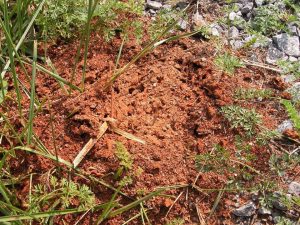
Fire ants may be small, but their impact on your home and yard can be huge. Ever wondered why these tiny invaders seem to show up uninvited?
Understanding their behavior is the key to keeping them at bay. Fire ants are not just a nuisance; they’re aggressive, territorial, and always on the hunt for food and shelter. Warmer weather, moisture, and easily accessible food sources often draw them closer to homes, where they build large colonies in your yard or even sneak inside. These pests can become a serious problem if not dealt with properly.
In this guide, we’ll break down what drives fire ants to invade and how you can protect your space from these unwanted guests. Knowing what makes them tick will help you defend your home and yard more effectively!
How Do Fire Ants Choose Where to Build Their Colonies?
Fire ants are highly adaptable and resourceful when choosing locations for their colonies. Typically, they prefer warm, sunny environments that provide easy access to food sources. Their nests are often found in soil, but they can also establish colonies in other materials like mulch, debris, or even inside wall voids and attics.
One key factor in colony placement is moisture. Fire ants are attracted to areas with adequate moisture levels, which is essential for survival. They often build their nests in well-drained soils, as overly saturated areas can lead to flooding and the destruction of their colonies. This adaptability allows them to thrive in various environments, from urban settings to agricultural lands.
When fire ants invade an area, they typically scout potential nesting sites. Worker ants will search for suitable locations, taking note of factors such as temperature, light exposure, and proximity to food sources. If they find a favorable spot, they will begin to excavate and create a network of tunnels, allowing their colony to grow and expand.
Understanding fire ant nesting habits is crucial for homeowners. By identifying potential nesting areas, such as warm, sunny spots with loose soil, you can take proactive measures to deter them from setting up colonies near your home.
What Environmental Factors Attract Fire Ants to Homes and Yards?
Fire ants can quickly take over your yard and even sneak into your home if the conditions are right. But what exactly attracts them? Understanding the environmental factors that draw these pests to your space can help you prevent an infestation. Here are the key things fire ants look for:
- Warmth and Moisture: Fire ants thrive in warm, humid environments. They are especially active during the spring and summer months when temperatures rise and after heavy rains. Moist soil makes it easier for them to build their nests.
- Food Sources: Fire ants are constantly on the lookout for food. Any food left outdoors, such as pet food, birdseed, or sugary substances, can easily attract them. Even small crumbs can be enough to draw them closer.
- Shelter: Fire ants prefer areas where they can create their colonies safely. Yards with thick vegetation, mulch, or piles of wood offer perfect hiding spots. They also tend to move indoors during extreme weather conditions like drought or heavy rainfall.
- Disturbed Soil: Construction, landscaping, or any ground disturbance can encourage fire ants to move in and build their nests, taking advantage of newly disturbed earth.
By understanding these factors, you can take steps to reduce the likelihood of fire ants invading your home and yard, keeping your space safe and pest-free.
How Do Fire Ants Behave When Their Nests Are Disturbed?
Fire ants are known for aggressively defending their nests. When their colonies are disturbed, their behavior can change dramatically. Disturbances can occur from digging in the garden, mowing the lawn, or inadvertently stepping on a nest.
When a nest is disturbed, worker ants respond quickly, releasing alarm pheromones that signal other ants to mobilize. This chemical signal alerts the colony to the threat, prompting a swarm of ants to emerge from the nest and defend their territory. Fire ants are notorious for their ability to attack in large numbers, often overwhelming their perceived threats.
Once alerted, fire ants will approach the source of disturbance with purpose. They can sting multiple times, injecting venom that causes a painful burning sensation and can lead to allergic reactions in some individuals. This aggressive behavior is a key characteristic of fire ants, making them particularly challenging when they invade residential areas.
Understanding how fire ants react to disturbances is essential for preventing painful encounters. It’s important to be cautious when working in areas where fire ants are known to nest and to avoid disturbing their colonies. If you find yourself near a nest, it’s best to retreat slowly and calmly to avoid provoking them further.
What Makes Fire Ants Aggressive When They Invade Human Spaces?
Several factors contribute to fire ants’ aggressive behavior when they invade human spaces. One primary reason is their instinct to protect their colonies. Fire ants are highly social insects that work together to defend their nests from perceived threats, and human activity can be seen as an invasion of their territory.
Another contributing factor is the availability of food and resources. Fire ants are opportunistic feeders, and they are drawn to human food sources, whether it’s leftover pet food, spilled drinks, or trash. The scent of food can lure fire ants into yards and homes, increasing the likelihood of aggressive encounters as they seek out these resources.
The presence of moisture also plays a role in fire ant aggression. Areas with water sources, such as leaking pipes or puddles, can attract fire ants and encourage them to invade nearby structures. Once they establish a presence, they may aggressively defend their foraging grounds.
Additionally, seasonal changes can influence fire ant behavior. During warmer months, fire ants become more active and aggressive as they seek food and expand their colonies. They are particularly aggressive in the spring and summer when their populations peak.
Recognizing the factors contributing to fire and aggression can help homeowners take preventive measures to minimize their risk of encountering these pests. Sealing food sources, addressing moisture issues, and maintaining a well-kept yard can help deter fire ants from invading your space.
Keep Your Property Fire-ant-free with Freedom Pest Services
Understanding fire ant behavior is crucial for effectively managing and preventing infestations in your home and yard. By recognizing how they choose nesting sites, the environmental factors that attract them, and their aggressive nature when disturbed, you can take proactive steps to keep these pests at bay.
At Freedom Pest Services, we are dedicated to helping you protect your home from unwanted pests like fire ants. Our expert team can assess your property, identify potential attractants, and implement effective pest control solutions tailored to your needs. Don’t let fire ants ruin your outdoor experience—contact us today to schedule a consultation and take the first step toward a pest-free environment!
